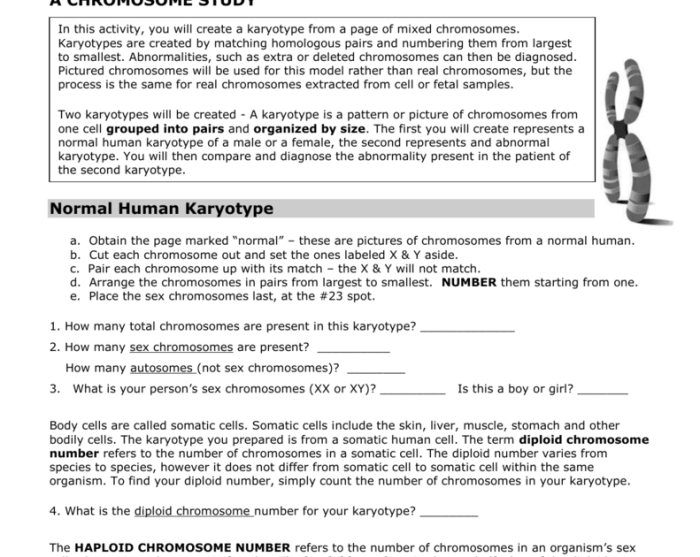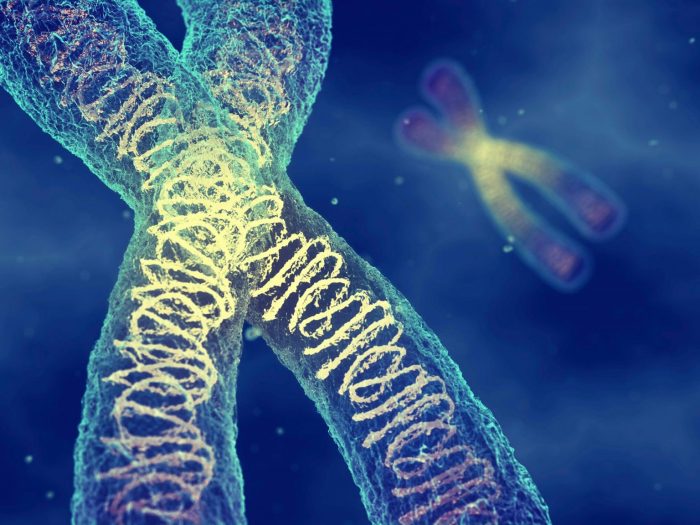A chromosome study answer key – Dive into the world of chromosomes with our comprehensive answer key! Embark on a journey to unravel the complexities of chromosome analysis, a technique that holds the power to unlock the mysteries of our genetic makeup.
Delve into the methods and procedures employed in chromosome analysis, including karyotyping and FISH. Witness the meticulous steps involved in preparing and deciphering chromosome samples, gaining insights into their applications in both clinical and research settings.
Introduction
Chromosome studies are crucial in understanding the genetic makeup and health of individuals. They involve analyzing the number, structure, and behavior of chromosomes, which are thread-like structures in cells that carry genetic information.
Key terms and concepts in chromosome analysis include:
Karyotype
A karyotype is a complete set of chromosomes arranged in a standardized format, allowing for the identification of chromosomal abnormalities.
Aneuploidy
Aneuploidy refers to an abnormal number of chromosomes, either more or less than the typical two copies.
Polyploidy
Polyploidy occurs when an organism has more than two complete sets of chromosomes.
Chromosomal Translocations
Chromosomal translocations involve the exchange of genetic material between different chromosomes.
Methods and Procedures

Chromosome analysis involves a range of techniques used to study the structure, number, and arrangement of chromosomes. These methods are crucial in diagnosing genetic disorders, understanding the genetic basis of diseases, and conducting research in genetics.
Karyotyping, A chromosome study answer key
Karyotyping is a technique that creates a visual representation of an individual’s chromosomes. It involves capturing images of chromosomes during cell division, arranging them according to size and banding patterns, and identifying any abnormalities.
Karyotyping is commonly used to diagnose chromosomal disorders such as Down syndrome, Turner syndrome, and Klinefelter syndrome. It can also be used in prenatal testing to detect chromosomal abnormalities in the fetus.
Fluorescence In Situ Hybridization (FISH)
FISH is a technique that uses fluorescent probes to identify specific DNA sequences on chromosomes. These probes bind to complementary sequences on the chromosomes, allowing researchers to visualize the location and copy number of specific genes or chromosomal regions.
Now that you have a better understanding of a chromosome study answer key, you may be curious about other skincare procedures. A microderm infusion is a popular treatment that combines exfoliation and hydration. It can help improve the appearance of fine lines, wrinkles, and acne scars.
What is a microderm infusion ? It’s a great way to achieve a more youthful and radiant complexion. If you’re considering a microderm infusion, be sure to do your research and find a qualified professional. With proper care, you can enjoy the benefits of this treatment for years to come.
After learning about microderm infusions, you may want to revisit the chromosome study answer key for further insights.
FISH is used in a variety of applications, including identifying chromosomal translocations, deletions, and amplifications. It is also used in prenatal testing to detect specific genetic disorders, such as microdeletion syndromes.
Interpretation of Results
Interpreting chromosome banding patterns involves identifying distinct regions along the chromosomes, each with a unique pattern of light and dark bands. These patterns serve as landmarks for identifying specific chromosomes and detecting any abnormalities in their structure or number.
Chromosomal abnormalities can be classified into two main types: numerical and structural. Numerical abnormalities refer to an incorrect number of chromosomes, such as having an extra copy (trisomy) or missing a copy (monosomy) of a particular chromosome. Structural abnormalities involve changes in the structure of chromosomes, such as deletions, duplications, inversions, or translocations.
Numerical Chromosomal Abnormalities
- Trisomy: An extra copy of a chromosome, leading to an abnormal phenotype. For example, trisomy 21 (Down syndrome) results from an extra copy of chromosome 21.
- Monosomy: Missing one copy of a chromosome, often resulting in severe developmental abnormalities. For example, monosomy X (Turner syndrome) occurs when a female is missing one X chromosome.
Structural Chromosomal Abnormalities
- Deletions: Loss of a chromosomal segment, which can result in a variety of genetic disorders depending on the genes affected. For example, a deletion in the short arm of chromosome 5 can cause cri du chat syndrome.
- Duplications: Duplication of a chromosomal segment, which can lead to developmental problems and intellectual disabilities. For example, a duplication of the long arm of chromosome 22 can cause Phelan-McDermid syndrome.
- Inversions: Reversal of the orientation of a chromosomal segment, which can disrupt gene expression. Inversions can be pericentric (involving the centromere) or paracentric (not involving the centromere).
- Translocations: Exchange of chromosomal material between two different chromosomes, which can result in a variety of genetic disorders. For example, a translocation between chromosomes 9 and 22 is associated with chronic myeloid leukemia.
Chromosomal abnormalities are diagnosed through karyotyping, a technique that involves staining and examining chromosomes under a microscope. Treatment options for chromosomal abnormalities vary depending on the specific abnormality and its severity. Some abnormalities can be managed with supportive care, while others may require surgical intervention or other therapies.
Applications of Chromosome Analysis: A Chromosome Study Answer Key

Chromosome analysis plays a vital role in medicine, aiding in the diagnosis, management, and prevention of genetic disorders. It is particularly valuable in prenatal diagnosis and genetic counseling, where it provides crucial information about an individual’s genetic makeup.
Chromosome analysis has significantly contributed to our understanding of human genetics. By identifying chromosomal abnormalities, researchers have gained insights into the genetic basis of various diseases and developmental disorders.
Role in Prenatal Diagnosis and Genetic Counseling
Chromosome analysis is routinely used in prenatal diagnosis to detect chromosomal abnormalities in the developing fetus. It is typically performed on amniotic fluid or chorionic villus samples obtained through amniocentesis or chorionic villus sampling. By analyzing the chromosomes in these samples, genetic counselors and medical professionals can assess the risk of the fetus having a genetic disorder.
Genetic counseling is an essential aspect of prenatal diagnosis. It involves providing information and support to prospective parents about genetic disorders and their potential impact on their child. Chromosome analysis results play a critical role in genetic counseling, enabling counselors to discuss the implications of specific chromosomal abnormalities and provide appropriate recommendations.
Applications in the Diagnosis and Management of Genetic Disorders
Chromosome analysis is also widely used in the diagnosis and management of genetic disorders. It can identify chromosomal abnormalities associated with a range of conditions, including Down syndrome, Turner syndrome, and Klinefelter syndrome. Accurate diagnosis is crucial for providing appropriate treatment and support to individuals with genetic disorders.
In addition to diagnosis, chromosome analysis can provide valuable information for managing genetic disorders. It can help determine the severity of a condition, predict potential complications, and guide treatment decisions.
Contributions to the Understanding of Human Genetics
Chromosome analysis has made significant contributions to our understanding of human genetics. By identifying chromosomal abnormalities associated with specific genetic disorders, researchers have gained insights into the genetic basis of these conditions.
For example, the discovery of the extra chromosome 21 in Down syndrome led to a better understanding of the role of gene dosage in genetic disorders. Similarly, the identification of the Philadelphia chromosome in chronic myeloid leukemia provided crucial information about the genetic mechanisms underlying cancer.
Questions and Answers
What is the purpose of a chromosome study?
A chromosome study aims to identify and analyze chromosomal abnormalities, providing valuable information for genetic counseling, prenatal diagnosis, and the diagnosis of genetic disorders.
How are chromosomal abnormalities detected?
Chromosomal abnormalities are detected through chromosome analysis techniques such as karyotyping and FISH, which allow visualization and examination of chromosome banding patterns.
What is the clinical significance of chromosomal abnormalities?
Chromosomal abnormalities can have a range of clinical implications, including developmental disorders, intellectual disabilities, and an increased risk of certain diseases.